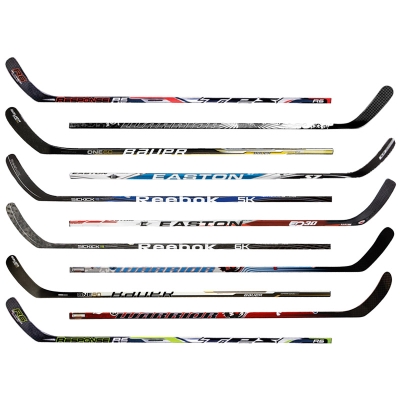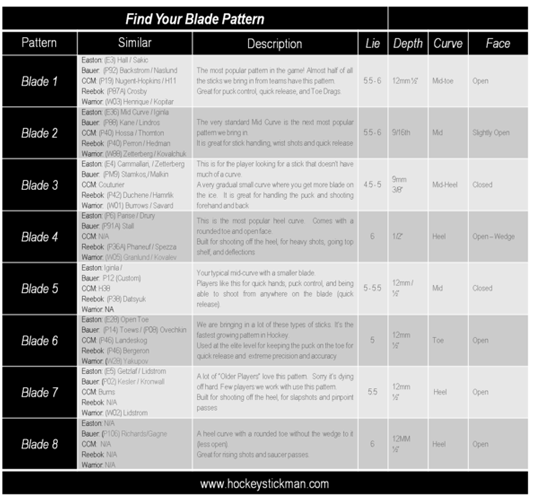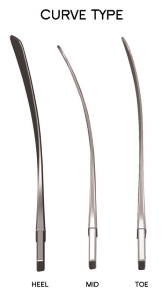In case you are new to the sport, the hockey stick is the sport’s equivalent to a baseball player’s bat, a golfer’s club, a bowler’s ball, etc. Selecting the right one is always of utmost importance. When you go on a scoring streak, you will be babying your stick and proclaiming its greatness to anyone willing to lend an ear. However, when you go through a scoring drought, if you don’t break down and smash it over the bench wall (which we do not encourage,) you will be trolling the pro shop and your teammate’s sticks looking for a replacement.
Before we get too far into this and for those of you not familiar with me or my employer, full disclosure: we, at Twig Hockey Company, make and sell hockey sticks. This doesn’t mean I’m going to write a piece that is skewed completely to our product. Our product isn’t for everyone and isn’t meant to be. I just want you to gain a little hockey knowledge and maybe praise my personal greatness to everyone you know when you are done reading.
Types of Sticks
Hockey sticks were traditionally made out of wood and wood proved to be a great product for a really long time. In more recent years, many material and construction advancements were made in stick construction that have rendered the wooden stick obsolete. Today, the most desired sticks on the market are a one-piece composite composed of 100% carbon fiber. These sticks are significantly lighter other types and the force needed to flex the stick is more easily adjusted at manufacturing, producing a more consistent and stronger performing hockey stick that shoots harder than its counterparts. There are also many levels of stick below the complete carbon fiber models that have varying amounts of fiberglass used in place of carbon. Generally a stick’s weight will increase and its price will decrease as the fiberglass content increases in the stick. Even among the complete carbon fiber models available today, differing grades of carbon fiber are used in construction by different manufacturers depending on the torque and strength requirements for the specific stick model. Hockey is a very rough game at the highest levels and, for this reason, the pro model sticks generally are built with the highest grades of carbon fiber and with it, carry the highest price tag at $260+.

Despite the one-piece label that sticks of today carry, today’s composite hockey sticks are actually built as two pieces, the blade and the shaft. Then, depending on the manufacturer’s proprietary method of construction, bonding, and finishing the two pieces together, they achieve a true one piece status. To the naked eye, it is usually quite difficult to find the seam in a one-piece composite hockey stick. Some older model composite sticks are actually two pieces and were sold as two pieces that were glued together after manufacturing. They tended to be bottom heavy and have become obsolete as well.
It’s also important to note that all composite hockey sticks will wear out and performance will degrade as this happens. The constant pressure of flexing the sticks as well as the regular banging and poking of hockey eventually breaks down the resin and carbon fiber in the stick and makes it feel much more “whippy” and soft. A recreational, beer-league player may be able to get two years out of a good composite stick depending on their frequency of play. More competitive levels of the sport can go through many more sticks in this period as their skill and frequency of play put more natural abuse on the sticks. A relatively new product being produced by Colt Hockey is trying to combat this breakdown. Their new sticks are graphite constructed and then dipped in nano steel that is designed to strengthen the stick in order to increase its longevity. I have yet to personally use one, but reviews are very good. Specs list it heavier than other high-end composite sticks on the market but it’s still certainly on the lighter end of sticks.
Size and Shape of Sticks
The length of stick you choose is really up to you. Many folks in the industry will advise you to get a stick that hits your chin when on its toe and you are on your skates. This is a good starting point if you have no idea, but really its completely personal preference as to what you should use. In my experience, defensemen tend to want a bit longer stick to increase reach and poke check chances and forwards may lean to the shorter side of sticks to keep the puck a bit closer for better stick handling. Sticks come in junior, intermediate, and senior sizes with the shaft diameter and length of the stick increasing as you move from junior through to senior sizes.
Flex
The flex is a number denoting the stiffness of the shaft. It’s a measurement of the amount of force it takes to bend the shaft. The more force it takes, the stiffer the shaft, and ultimately the harder the shot. You have to find the right flex for you because too soft of a flex and your shot won’t go anywhere, and too stiff of a flex and you won’t be able to get the puck off the ice/floor. A good point of reference for this is to ½ your body weight. Pick the closest flex to this number and you’ll probably be all set for a few beauty clappers.
Curves
Stick blades come in right and left hand models. There are many trains of thought as to which one is better for your specific handedness. Right-handed people in the U.S. tend to play with right-handed sticks. However, in Canada, right-handed people tend to play with left-handed sticks. Some studies cite the dominant hand on top (as is the preference in Canada) as being the most important. Other studies prefer the dominant hand down (the U.S. preference) to generate more force on a shot. Let me know why you play what you do below, I’m curious.

Stick curves are either curved in the middle, at the heel, or at the toe of the blade. The differing angles of curve and location can assist in certain types of play. For most people, it’s usually better to stick with the most common blade patterns because they are popular for a reason; they work for a lot of people.

Lie
Stick lie is a number measuring the angle of the blade to the ice. The goal is to find a blade that allows you to keep the entire blade on the ice while you skate naturally. You don’t want to have to accommodate for the stick blade. A lower value denotes a lower angle (the shaft is more flat to the ice) and higher values denote higher angles (shaft is more upright.)
The patterns of blades available to the retail hockey stick market (the ones regular players like us get to pick from) really limit the impact curve and lie selection. The most common blade patterns have a specific lie that is the same across all manufacturers. So, unless you’ve got a pro contract where they are custom building blade patterns for you (why would you be reading this article,) you get to pick a curve/lie combo that you like; but not each separately.

What Does All This Mean?
- If you care at all about your game, get a new one-piece 100% carbon stick. Anything less is just inferior.
- Hockey stick construction and design techniques really haven’t varied much in the past couple years unless you are looking at durability. If this is your concern, try a Colt.
- Hyper-drive kick zones, quick-release tapers, and eLASTech resins are mostly marketing mumbo-jumbo. Their actually margin of performance improvement of a hockey stick is probably something like .00001%. It's mostly just to keep you fresh and wanting their new stick.
- If you play in the NHL, think you are going to some day, or are one of those guys who thinks the label on his stuff defines him as a person, go buy a $260+ top-end stick from the big brands. They are really nice and will perform well for you. As long as you can afford it, you won’t find a better stick.
- Now for the plug: The rest of you senior size stick users who aren’t ready to make a car payment each time your stick breaks should check out our Twig. It performs comparable to the big name, pro-level sticks and costs way less. It's the cheese!


